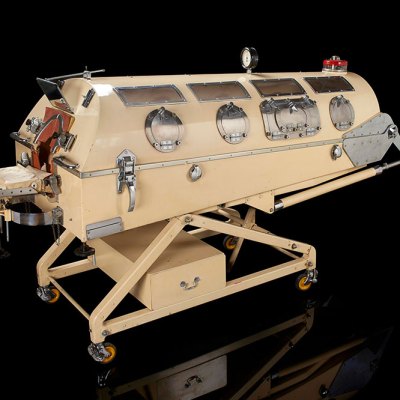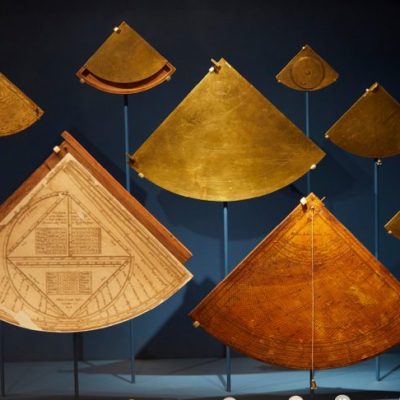Portraiture was not a liberal art in the 18th century. Commentators from the Earl of Shaftesbury to Benjamin West all agreed that recording a likeness was a more mechanical skill than the imaginative art of history painting, to which all artists should aspire. Yet people wanted their status and achievements commemorated, and portrait painters became wealthy and influential figures in society. Sir Joshua Reynolds, the first president of the Royal Academy was, after all, a ‘face painter’. Today, too, the portrait can stand on the margins. Unless featuring in an exhibition or book specifically on the art of portraiture, it is all too easy to use the image of a personality simply illustratively: to put a face to the name.
When dealing with men (and women) of science, the temptation is perhaps all the greater. These figures might appear to be visible in their portraits in an uncomplicated way, surrounded by their ideas, inventions or publications, with frowning brows, deep in thought, or proudly lifted chins. But a portrait is always a construction of a person, telling us as much about how society saw or wished to see these figures, as it does about how they themselves wished to be presented. Historians of science, too, will tell you that scientific ideas are just as shaped by society. Shaftesbury, Reynolds and West, indeed, would not have known of their contemporaries as ‘scientists’ (a word not coined until the 19th century), but as natural philosophers, men of science or other appellations according to status and source of income. Yet hierarchies remained: men of learning were generally differentiated from the mechanical men concerned with instruments and practical invention, however much the achievements of one might depend upon the other.
Like their portrait-painting brethren, men concerned with the ‘mechanic arts’ were often seen as lower down the intellectual hierarchy, although this was not always clear-cut. The attention to detail and exactness required by a portrait attracted degrading associations with Dutch painting, and its concern with everyday detail and ordinary life. Mechanical rather than intellectual scientific endeavour carried similar connotations of the mundane. The Reverend James Granger barely included mechanical men among the plethora of figures worthy of illustration for his Biographical History of England (1769). The movement of such arts up that hierarchy, in both portraiture and science, can be seen as one of the grand narratives for the beginning of the modern age: in the increasing confidence shown by mechanical men in their portraits, and in the portraitists who practiced this mechanic art.
The National Maritime Museum in Greenwich is currently staging an exhibition which touches on part of that grand narrative. ‘Ships, Clocks & Stars: The Quest for Longitude’ (until 4 January 2015) tells the story of the search to find a means of measuring longitude at sea in 18th-century Britain. Both naval and commercial interests could see the benefits of improving the speed, efficiency and safety of voyages. The attempt to do so brought together politicians, naval men, royals, men of science, artists, satirists and mechanics in an unusual way, focusing wide public and specialist attention – both serious and satirical – on a series of potential solutions. The two major proposals to emerge – astronomical use of lunar distances and mechanical use of timekeepers – were complementary, although they have often been seen as rivals. In tracing the complex story of the people, machines and ideas involved in solving the longitude problem, portraits play an important role in ‘Ships, Clocks & Stars’. The show features 16 portraits in oil, and others in watercolour, chalk and enamel. Together, they give visitors a broad survey of changing representations of scientific and mechanical men over more than a century.
Isaac Newton (1702), Godfrey Kneller. National Portrait Gallery, London

The imposing figure of Isaac Newton (1642–1727) introduces the Longitude Act, which was passed in 1714 to encourage a successful means of finding longitude at sea. In Sir Godfrey Kneller’s 1702 portrait, Newton is the archetypal early-18th-century man of learning, both classical and courtly. In elegant full-bottom wig and draped robes, over an open shirt, Newton echoes a Roman bust as well as a fashionably dressed member of the elite. The oval format would make this portrait ideal for the library of a gentleman of learning, with Newton a particularly popular and illustrious subject whose portrait conferred status on its owner. He often formed part of a group of great men portrayed in stately homes, along with Francis Bacon, William Shakespeare,
John Locke, Alexander Pope and others, the most famous being Stowe’s Temple of British Worthies. Yet, Kneller’s portrait gives no obvious indication of Newton’s status as a man of science, no papers or publications. He plays his part in the exhibition primarily as parliamentary advisor on the longitude problem rather than as a reclusive mathematician. Likewise, the very consistency of his portrait with so many images of the time gives its exclusivity the lie. Kneller was criticised for running his studio like a factory, where each part was produced by a different assistant. This was precisely the division of labour that Adam Smith would advocate over 70 years later.
Newton’s advice to parliament in 1714 concerned four of the main methods known to offer potential means of finding longitude. He voiced doubts about each in its current state of development, including the hopes of making a clock that could accurately keep time at sea, since movements of the ship and temperature fluctuations caused clockwork to run inaccurately. ‘Ships, Clocks & Stars’ features a champion for each solution, some in surprisingly youthful portraits for what are usually thought of as elder statesmen of science, notably the first Astronomer Royal, John Flamsteed, and his successor, Edmond Halley. Easily the most striking image is Caspar Netscher’s c. 1671 portrait of Christiaan Huygens (1629–95), young and handsome in his long wig and elaborate costume with lace collar and cuffs. Leaning on a plush red velvet cushion, surrounded by an ornate table and swagged curtain, with a classical sculpture visible in the background, Huygens might be any wealthy, fashionable young man of taste. Nothing suggests his obsessive work to develop a pendulum clock that might work at sea.
Christiaan Huygens (c. 1671), Caspar Netscher. Haags Historisch Museum, The Hague

Following in Huygens’ footsteps, the best-known protagonist in the longitude story is the clockmaker John Harrison (1693–1776), made famous by Dava Sobel’s book of 1995, and the subsequent TV film (2000). Harrison’s four celebrated timekeepers, the last of which would bring him closest of anyone to receiving the ‘great reward’ of 20,000 [pounds sterling] offered by the Longitude Act, are some of the most well-known treasures normally displayed at the Royal Observatory, Greenwich. Ticking quietly in their glass cases, these clocks are often seen as the best portraits of a unique, ingenious and misunderstood mind. Behind them in the current exhibition hangs Thomas King’s three-quarter length seated portrait of Harrison, on loan from the Science Museum. Painted in 1767, at the height of his increasingly public disagreements with the Commissioners of Longitude (appointed under the 1714 Act to assess proposed schemes), the portrait presents a sturdy, confident and respectably dressed man who could only be a mechanic. Behind Harrison’s chair stands one of his major innovations, the gridiron pendulum, while in the background to the left is his third sea-clock (H3). One hand rests on his hip, while the other sits on the table, above a diagram of watchwork, holding the pocket watch made to his design by London watchmaker John Jefferys. This watch is crucial, since it was the timekeeper in which Harrison first tried out the innovations that enabled his sea-watch (H4) to work so well at sea. This is clearly a portrait of his machines as much as it is of Harrison. His image is incomplete without them, and together they create a likeness that could be of no one else, at a time when Harrison was arguing fiercely for the rewards he insisted he was due.
John Harrison (1693–1776) (1767), Thomas King. Science Museum, London

An exact copy of H4, Harrison’s successful sea-watch, was taken to the Pacific by Britain’s most famous explorer, Captain James Cook (1728–79). An expert navigator and able tester of both the lunar-distance and timekeeper methods, Cook was elected a Fellow of the Royal Society in 1776, as well as being awarded the Society’s most prestigious accolade, the Copley Medal (which Harrison had also won). In Nathaniel Dance’s portrait (1775–76), Cook is the perfect Enlightenment figure, both fashionable and accomplished, but also a practical man of science. He sits in his dress uniform, hair (or perhaps wig) powdered, with his hat resting on the table. Behind him, the usual classical column of fashionable portraiture gives way to a generic vista of sea and sky, evocative of Cook’s usual operating environment, without directly sullying him by association with a detailed image of ship or shore. Yet he has also moved his hand from the conventional waistcoat pose to point at New Holland (Australia) on his own, highly accurate, chart of the Southern Ocean. He leans forward, the active man, about to engage in conversation, and the book at his side is likely his Journal of the second voyage, soon to be published. The portrait was commissioned by Cook’s fellow voyager, the gentleman-naturalist Joseph Banks, who accompanied him on the first circumnavigation and would go on to be President of the Royal Society for more than 40 years. Hung on Banks’s library wall in Soho Square, London, Cook’s portrait was a specific statement of both his and Cook’s active scientific endeavours. This was very different from the more general gentlemanly interest in science that a portrait of Newton would have conferred in other libraries.
John Arnold and Family (c. 1783–87), Robert Davy. Science Museum, London

On his second voyage of 1772–75, Cook also tested three sea-watches by the up-and-coming watchmaker John Arnold (1736–99). Arnold was a man with aspirations, who expertly exploited social and commercial networks, but whose success arose from technical innovation. His portrait by Robert Davy of c. 1783–87 presents another shift in scientific portraiture. Arnold sits in a close family group with his wife Margaret and son John Roger, who would take over the family business at the end of the century. Father and son wear satin waistcoats and ostentatious gold buttons, while Margaret is fashionably attired with copious padding, expensive silk and flamboyant cap. John and his son look at each other, as John holds one of his innovative chronometer movements; Margaret, poised with quill and paper, looks out at the viewer. Davy presents a solid, middle-class family business in the process of refining and passing on highly-skilled horological knowledge, developed over years of concentrated mechanical work. This is a new breed of technological entrepreneur, although the large ornate portrait showing two generations self-consciously echoes the ancestral portraits of more established families.
This is more than a simple status image to fit John Arnold into existing patterns of portraiture; it is a statement of mechanical art and family industry, of skill maintained and passed on. Arnold has not achieved a single, unique act of invention like Harrison, or discovery like Cook, but the sustained, assured production of chronometers as an industrial and commercial practice. Davy’s portrait achieves this by creating a unique image where the mechanical arts mark the Arnolds out, clarifying and asserting their status.
Among the instruments, books and papers, the shiny brass and glass expected of an exhibition on the history of science and technology, the painted portraits in ‘Ships, Clocks & Stars’ play a subtle but important role: the changing story of the mechanical arts in 18th-century Britain was played out equally in instrument and iconography.
From the November 2014 issue of Apollo. Preview and subscribe here.


